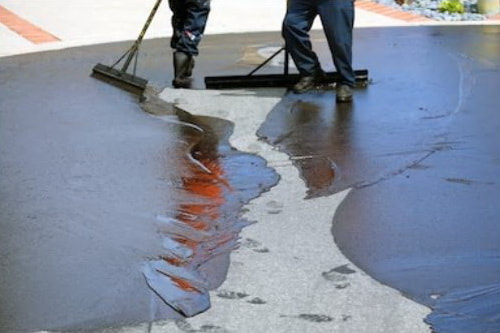Let loose the Possible: Regrading and Asphalt Sealing for Business Rooms
Let loose the Possible: Regrading and Asphalt Sealing for Business Rooms
Blog Article
Hot Mix Asphalt: A Lasting Solution for Pavement
Warm Mix Asphalt (HMA) has emerged as a leading sustainable option for sidewalk options, providing a myriad of ecological advantages and cutting-edge innovations. As the demand for environmentally friendly construction methods grows, exploring the subtleties of HMA's sustainability can offer beneficial insights into the future of pavement options.
Environmental Advantages of Warm Mix Asphalt

Additionally, Hot Mix Asphalt aids to reduce city heat island results. Its dark color absorbs sunlight, reducing the amount of warmth showed back right into the environment contrasted to lighter-colored pavements. This can decrease ambient temperatures in metropolitan locations, decreasing the need for air conditioning and eventually reducing energy intake.
On top of that, Hot Mix Asphalt contributes to enhanced stormwater management. Its permeable nature permits water to penetrate the pavement and recharge groundwater supplies, reducing overflow and the danger of flooding. These ecological benefits make Hot Mix Asphalt a lasting option for leading highways and roads.
Energy Effectiveness in HMA Manufacturing
Is power effectiveness a crucial element in the production of Hot Mix Asphalt (HMA)? Absolutely. Energy plays a significant function in the production of HMA, impacting both cost and environmental sustainability. One crucial facet of power performance in HMA manufacturing is using cozy mix asphalt (WMA) technologies (commercial parking lot paving). WMA enables the blending and placement of asphalt at lower temperatures compared to standard warm mix asphalt, leading to minimized energy usage during manufacturing. This procedure not just reduces fuel use however likewise reduces greenhouse gas discharges, making it a more eco-friendly option.
Furthermore, innovations in plant modern technologies have led to even more energy-efficient HMA production procedures. Modern plants are developed with features like recycled asphalt sidewalk (RAP) processing capacities, effective burner systems, and boosted insulation, all contributing to power cost savings. By optimizing power use in HMA manufacturing, the industry can lower its carbon footprint while keeping premium sidewalk products. Power effectiveness is, therefore, a critical consideration in making certain the sustainability of Warm Mix Asphalt manufacturing.
Recyclability of Hot Mix Asphalt
The recyclability of Warm Mix Asphalt (HMA) is a pivotal element of its sustainability and lasting ecological impact. HMA is among one of the most recycled products in the United States, with over 100 million bunches of reclaimed asphalt sidewalk (RAP) being recycled annually in brand-new pavement construction. Reusing HMA supplies several environmental advantages, such as lowering the requirement for virgin products, decreasing energy consumption during manufacturing, and decreasing the amount of waste sent out to land fills.
The procedure of reusing HMA includes milling the existing pavement, squashing it into smaller sized pieces, and blending it with new accumulation and asphalt binder to produce a recycled mix. In general, the recyclability of HMA plays a considerable role in advertising sustainable practices within the sidewalk market.

Long-Term Efficiency of HMA
Asphalt sidewalks show resilience and durability over an extensive duration, showing the long-lasting efficiency of Hot Mix Asphalt (HMA) The durability of HMA can be credited to its ability to withstand heavy traffic loads, rough climate condition, and the effects of aging. Studies have revealed that well-designed and appropriately built HMA pavements can last for twenty years or more with regular upkeep. The key to making the most of the long-term performance of HMA exists in making use of high-grade materials, following ideal practices in building, and executing effective maintenance strategies. Appropriate drainage, routine evaluations, and timely repair work are necessary for protecting the structural click to find out more integrity of HMA sidewalks in time. Furthermore, improvements in HMA innovation, such as the use of polymer-modified binders and cozy mix asphalt, have actually even more boosted the resilience and longevity of HMA sidewalks. By prioritizing top quality building and maintenance practices, HMA remains to confirm itself as a cost-efficient and sustainable remedy for durable pavement infrastructure.

HMA: Sturdiness and Sustainability
Demonstrating both durability and sustainability, Warm Mix Asphalt (HMA) has come to be a keystone in the building and construction of resilient pavement frameworks - angled parking. HMA's durability comes from its capability to stand up to hefty tons, harsh climate condition, and high web traffic volumes, making it a trusted option for highways, highways, and airport terminal runways. The structure of HMA, which typically consists of aggregates, binder, and filler, plays a critical function in boosting its longevity and resistance to tear and put on
Moreover, HMA's sustainability depends on its recyclability and energy-efficient manufacturing process. The capability to recycle redeemed asphalt sidewalk (RAP) in brand-new HMA mixes minimizes the demand for virgin materials and lessens the ecological impact of pavement building and construction and use this link maintenance. Additionally, the energy performance of generating HMA lies in its lower mixing temperature levels contrasted to other pavement materials, resulting in minimized power intake and greenhouse gas emissions.
Final Thought
In conclusion, hot mix asphalt (HMA) provides a lasting service for sidewalk with its eco friendly characteristics. HMA's recyclability, power performance in manufacturing, and lasting longevity make it a green choice for road building.
HMA is one of the most recycled materials in the United States, with over 100 million heaps of reclaimed asphalt sidewalk (RAP) being reused each year in brand-new pavement building and construction.The process of recycling HMA involves crushing the existing pavement, squashing it into smaller sized items, and mixing it with brand-new accumulation and asphalt binder to create a recycled mix.Asphalt sidewalks demonstrate durability and durability over an extended period, mirroring the long-lasting performance of Hot Mix Asphalt (HMA) Additionally, innovations in HMA technology, such as the use of polymer-modified binders and cozy mix asphalt, have additionally enhanced the longevity and durability of HMA sidewalks. The ability to reuse recovered asphalt pavement (RAP) in brand-new HMA my latest blog post mixtures minimizes the demand for virgin materials and decreases the ecological influence of pavement building and construction and maintenance.
Report this page